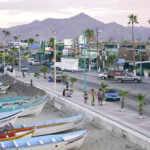Does It Snow Anywhere In Mexico? Yes, it does! Gaymexico.net knows Mexico is more than just sun-kissed beaches and vibrant culture; it’s also home to surprising winter wonderlands, particularly in its northern regions and at higher altitudes, offering a unique experience for LGBTQ+ travelers and adventure seekers. Discover the snow-covered peaks and charming winter destinations for a unique gay vacation, embracing winter escapades, snowy landscapes, and elevated altitudes for a refreshing change of pace.
1. Embracing the Unexpected: Snow in Mexico
Does it snow in Mexico? Absolutely! While Mexico is renowned for its beautiful beaches and warm climate, certain regions experience snowfall, primarily during the winter months.
This unexpected phenomenon transforms parts of the country into winter wonderlands, offering a unique and unforgettable travel experience. From snow-capped volcanoes to charming mountain towns, Mexico has something to offer every snow enthusiast.
2. Who Gets to Experience Snowfall in Mexico?
While snow in Mexico is not a daily occurrence, several regions are known for their wintery displays:
- Northern Mexico: States like Chihuahua, Coahuila, and Nuevo León often witness snowfall, especially in mountainous areas.
- High-Altitude Regions: The Sierra Madre Occidental, Sierra Madre Oriental, and the Trans-Mexican Volcanic Belt are prone to occasional snowfalls.
- Specific Peaks: Mountains like Pico de Orizaba, Nevado de Toluca, and Sierra Negra are renowned for their winter snowfall.
3. Top 17 Snow Destinations in Mexico
Here are 17 of the best places to witness the magic of snow in Mexico, perfect for a unique LGBTQ+ getaway:
3.1. Nevado de Toluca, State of Mexico
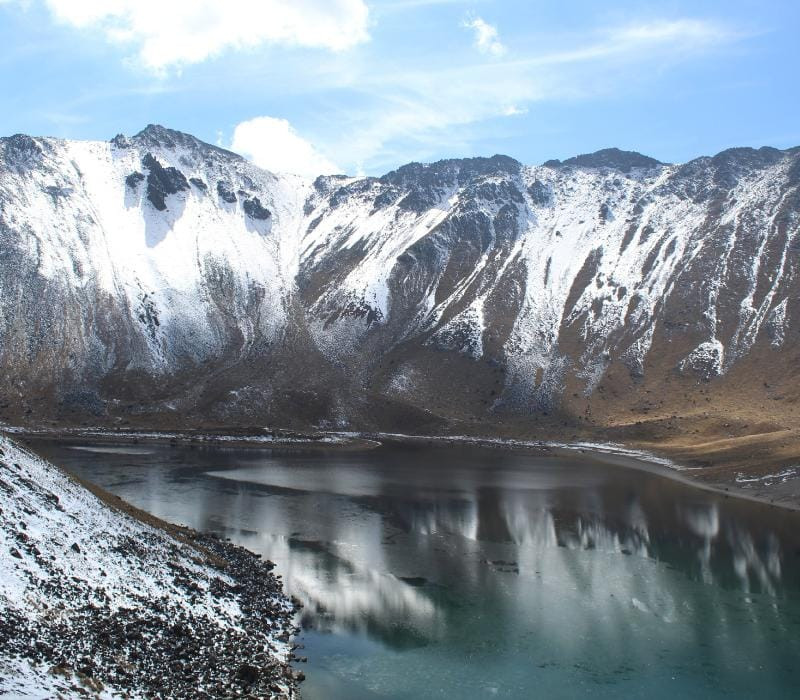 Nevado de Toluca covered in snow, Mexico
Nevado de Toluca covered in snow, Mexico
Nevado de Toluca is a dormant volcano located about 50 miles west of Mexico City, known for its stunning crater lakes.
The fourth-highest peak in Mexico, Nevado de Toluca is a popular destination for LGBTQ+ hiking enthusiasts offering challenging trails and breathtaking views. Pre-Hispanic archaeological sites around the lakes, where ancient rituals were performed, add to its cultural significance. Visit between November and March for the best chance to see snow.
Pro-tip: Book a Nevado de Toluca tour with an experienced local guide to navigate the trails safely and learn about the area’s history and culture.
3.2. Parque Nacional Izta-Popo, Puebla and State of Mexico
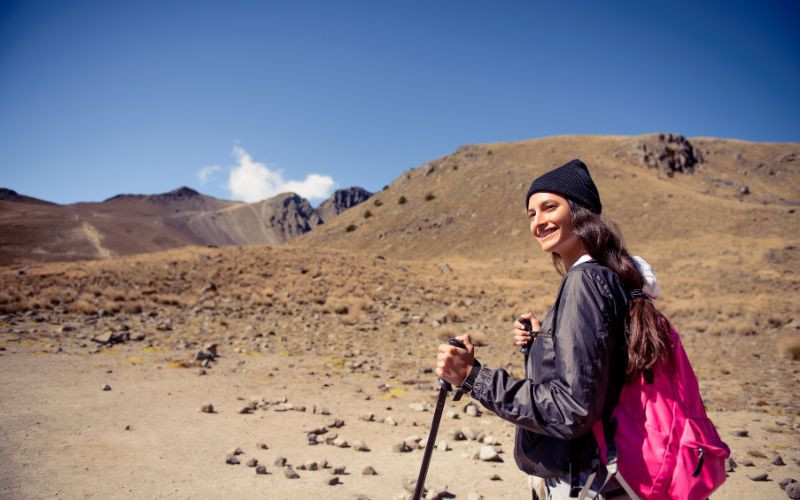 Snow-capped volcano in Parque Nacional Izta-Popo, Mexico
Snow-capped volcano in Parque Nacional Izta-Popo, Mexico
Nestled between Puebla and Mexico State, Izta-Popo National Park is home to two towering volcanoes: Iztaccíhuatl and Popocatépetl.
Established in 1935, this park is one of Mexico’s oldest and most ecologically diverse. Offers various hiking trails, from easy walks to challenging climbs. Keep an eye out for the elusive volcano rabbit and numerous bird species. The best time to visit is between November and January.
3.3. Sierra de Arteaga, Coahuila
 Log cabin in Sierra de Arteaga, Coahuila, Mexico
Log cabin in Sierra de Arteaga, Coahuila, Mexico
Sierra de Arteaga, often called the “Swiss Alps of Mexico”, is located in Coahuila.
Known for its alpine landscapes and Bosques de Monterreal, Mexico’s only ski resort. The coldest temperatures occur in December and January. Activities include skiing, golfing, horseback riding, and ATV tours.
3.4. Monterreal, Coahuila
Wondering, is there skiing in Mexico? Monterreal in Coahuila offers a unique skiing experience with an artificial slope and potential natural snowfall during the winter.
Often called the “Alps of Mexico”, it’s a perfect destination for beginners and experienced snow sports enthusiasts. Besides the slopes, enjoy golfing, tennis, and mountain biking.
3.5. Barranca del Cobre, Chihuahua
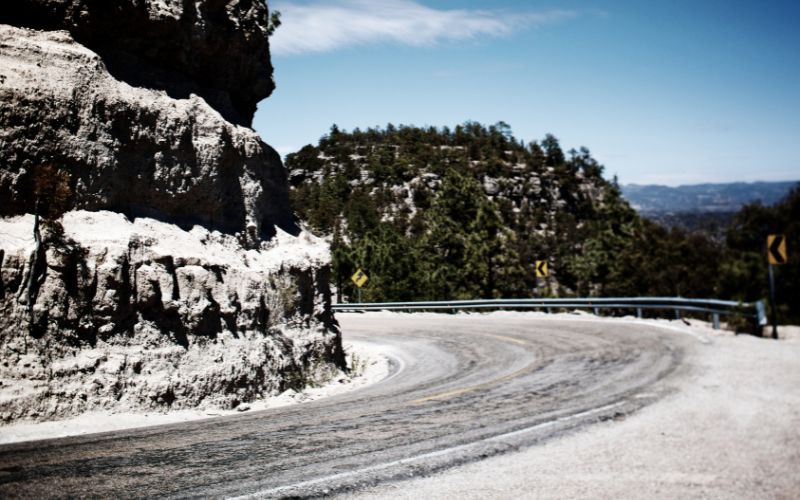 Highway leading to Barranca del Cobre, Mexico
Highway leading to Barranca del Cobre, Mexico
Barranca del Cobre, or Copper Canyon, is a network of canyons in Chihuahua, larger and deeper than the Grand Canyon.
Access the area via the El Chepe Train for spectacular views. The best time to visit for snow is from December to March.
Beyond hiking, enjoy mountain biking, rock climbing, and zip-lining. Explore the area’s rich biodiversity.
3.6. Creel, Chihuahua
 Log cabin in Sierra de Arteaga, Coahuila, Mexico
Log cabin in Sierra de Arteaga, Coahuila, Mexico
Creel is known for its magical winter landscapes and picturesque scenery, particularly from December to February.
This high-altitude town serves as a gateway to the Copper Canyon. Offers hiking, cultural visits to indigenous Tarahumara communities, local crafts, and natural sites like Valle de los Hongos and Lago Arareko Lake.
3.7. La Malinche, Tlaxcala and Puebla
 Hikers on La Malinche Volcano, Mexico
Hikers on La Malinche Volcano, Mexico
La Malinche, a dormant volcano on the border between Tlaxcala and Puebla, is a popular hiking and climbing destination.
Standing at more than 14,600 feet (4,461 m), it offers challenging trails during the snow season from December to February. The park surrounding La Malinche is rich in biodiversity.
3.8. Parque Nacional Pico de Orizaba, Puebla and Veracruz
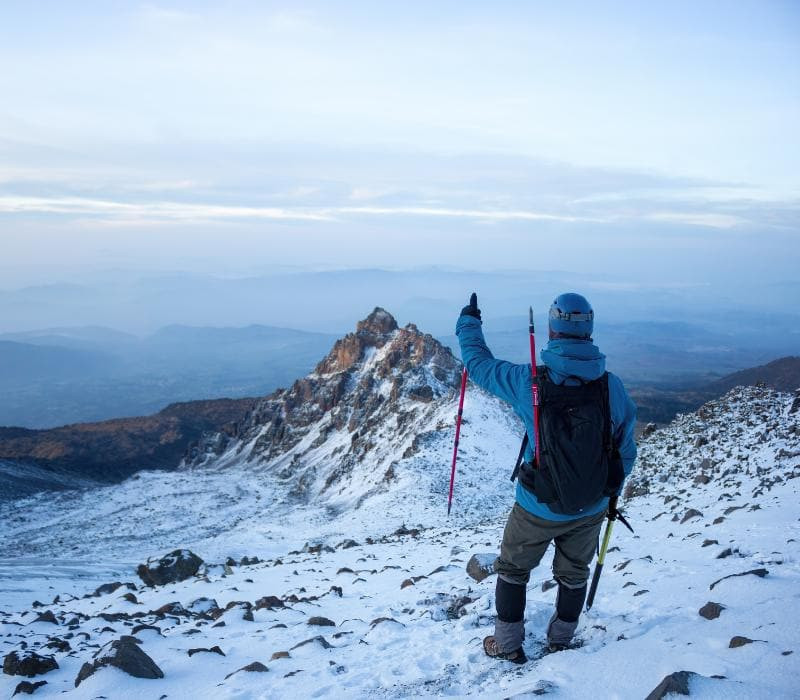 Snow-capped mountain of Pico de Orizaba, Mexico
Snow-capped mountain of Pico de Orizaba, Mexico
Pico de Orizaba is the tallest peak in Mexico and the third-highest in North America.
Located on the border between Puebla and Veracruz, this park features glaciers and a year-round snow-capped summit. The volcano rises approximately 18,491 feet above sea level (5,636 m), making it ideal for advanced mountaineering.
3.9. Volcán de Colima, Colima and Jalisco
Volcán de Colima, part of the Colima Volcanic Complex, experiences snow at higher altitudes during winter.
The summit, reaching about 13,386 feet (4,080 meters), often receives a blanket of snow. The area is popular for hiking and bird watching.
3.10. Cerro del Ajusco, Mexico City
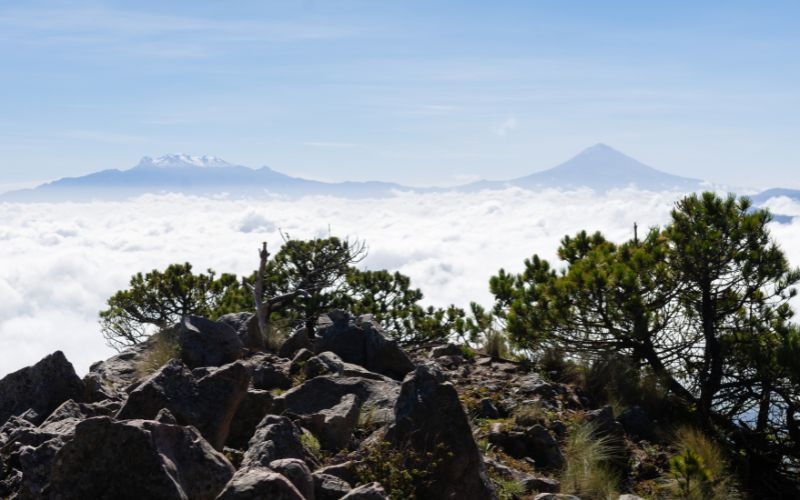 View from the peak of Cerro del Ajusco, Mexico
View from the peak of Cerro del Ajusco, Mexico
Located about 12.5 miles (20 kilometers) from Mexico City, Cerro del Ajusco is a peak in the Ajusco mountain range.
It is one of the most accessible spots for snow near Mexico City. During the winter months from December to February, the higher elevations can experience snowfall. Offers hiking, mountain biking, and panoramic views of Mexico City.
3.11. Cumbres de Majalca, Chihuahua
Cumbres de Majalca National Park, north of Chihuahua City, offers unique rock formations and pine forests.
This lesser-known park provides a quiet retreat for nature lovers. Winter brings snowfall, particularly from December through February. Offers scenic views and wildlife spotting.
3.12. Mexiquillo, Durango
 Man in a poncho at a lake in Sierra de Mexiquillo, Durango, Mexico
Man in a poncho at a lake in Sierra de Mexiquillo, Durango, Mexico
Mexiquillo is an incredible spot in the Sierra Madre range of Durango, known for its landscapes and regular snowfall during winter.
Visit between December and February for snow tubing and hiking. The natural setting is enhanced by waterfalls and forests, magical in the snow.
3.13. Nevado de Colima, Jalisco
Nevado de Colima, in Jalisco, is part of the Volcán de Colima volcanic complex.
Due to its high altitude, it is one of the few places in Mexico where snow is regularly seen. The park around Nevado de Colima is ideal for hiking and nature observation.
3.14. Parque Nacional Lagunas de Zempoala, Morelos and Mexico State
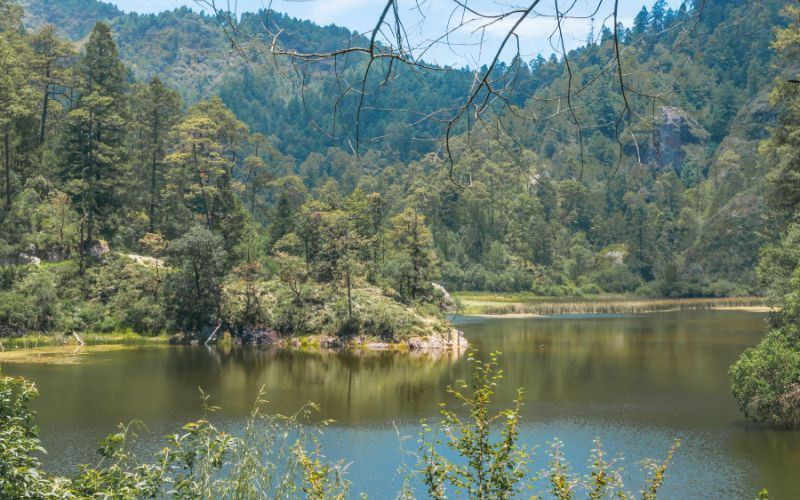 Lake in Parque Nacional Lagunas de Zempoala, Mexico
Lake in Parque Nacional Lagunas de Zempoala, Mexico
Known for its seven beautiful lakes, Parque Nacional Lagunas de Zempoala is located between Morelos state and the State of Mexico.
This park is also known for its mountainous landscape. The mountains occasionally receive snow in the colder months. Ideal for hiking, picnicking, and wildlife observation.
3.15. La Marquesa, Mexico City and Mexico State
La Marquesa, officially known as Parque Nacional Insurgente Miguel Hidalgo y Costilla, is a popular getaway between Mexico City and the State of Mexico.
One of the best day trips from Mexico City, it’s a favorite spot for city dwellers looking to experience snow during winter. Transforms into a picturesque landscape ideal for family outings with tubing and snowball fights.
3.16. Monte Tláloc, State of Mexico
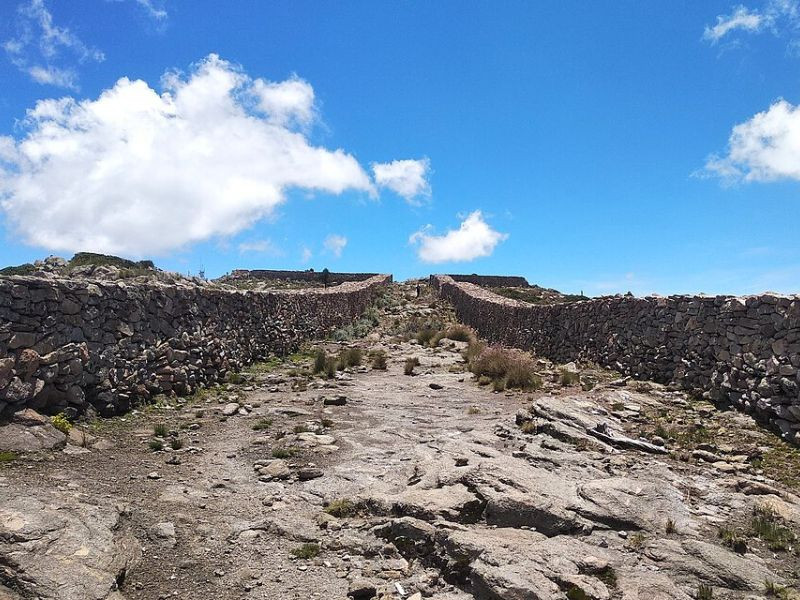 Aztec ruins on Mount Tláloc in Mexico
Aztec ruins on Mount Tláloc in Mexico
Mount Tláloc, in the State of Mexico, is steeped in historical and cultural importance.
Reaching an elevation of about 13,517 feet (4,120 meters), it occasionally sees snowfall from December to February. The Aztecs revered Monte Tláloc as a sacred site.
3.17. Cerro El Potosí, Nuevo León
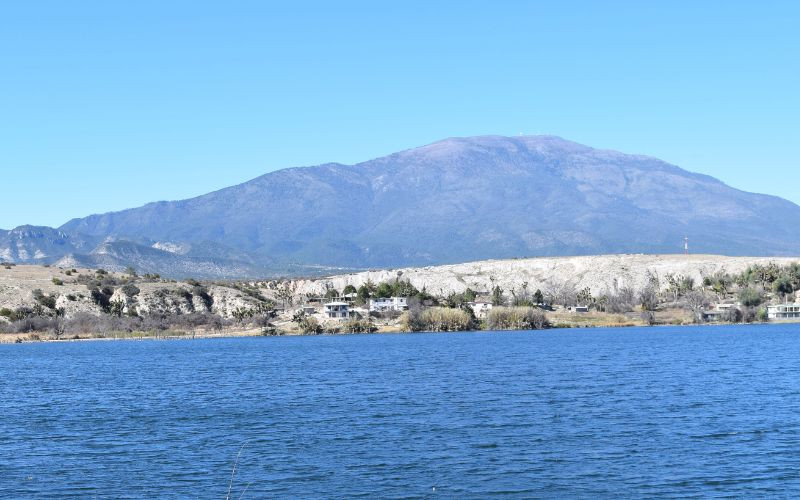 Cerro El Potosí, Nuevo León from afar
Cerro El Potosí, Nuevo León from afar
Cerro El Potosí in Nuevo León is known for its stark and rugged beauty.
Reaching up to 12,200-feet-high (3,720 meters), it’s one of the highest peaks in northeastern Mexico. Notable for its snowfall during winter.
4. Mexico City Snowfall: A Rare Sight
Does it snow in Mexico City? Snow in Mexico City is rare, having occurred only three times in the last 100 years.
Despite the city’s high altitude, actual snowfall is uncommon. Significant snowfalls occurred in 1940 and 1967, with a minor snowfall in 2022. Mexico City’s usual winter conditions involve chilly temperatures, but not freezing conditions required for snow.
4.1. Coldest Temperatures in Mexico City
In Mexico City, average winter temperatures typically range from highs around 71°F (about 22°C) to lows of 38°F (about 3°C).
January tends to be the coldest month, with temperatures occasionally dipping lower during the coldest nights.
5. Creel: Mexico’s Coldest City
The coldest city in Mexico is typically Creel, located in the state of Chihuahua.
Situated at a high elevation in the Sierra Tarahumara, it experiences very low temperatures during winter, sometimes dropping below freezing.
6. Planning Your Snow Adventure in Mexico
Ready to plan your snowy adventure in Mexico? Here are some tips to make the most of your trip:
- Check the Weather: Keep an eye on the forecast to determine the best time to visit your chosen destination.
- Pack Appropriately: Bring warm clothing, including thermal layers, waterproof gear, and sturdy hiking boots.
- Consider Altitude: If you’re visiting high-altitude areas, acclimatize gradually to avoid altitude sickness.
- Book Tours: Consider booking guided tours for a safe and informative experience.
7. FAQ: Snowfall in Mexico
7.1. Is it possible to see snow in Mexico?
Yes, it is possible to see snow in Mexico, especially in the northern regions and at high altitudes during the winter months.
7.2. What are the best places to see snow in Mexico?
Some of the best places include Nevado de Toluca, Parque Nacional Izta-Popo, Sierra de Arteaga, and Creel.
7.3. When is the snow season in Mexico?
The snow season typically runs from December to February, although some areas may experience snowfall as early as November or as late as March.
7.4. Does it snow in Mexico City?
Snow in Mexico City is rare, but it has happened on a few occasions.
7.5. What is the coldest city in Mexico?
Creel, Chihuahua, is typically the coldest city in Mexico.
7.6. Can you ski in Mexico?
Yes, you can ski in Mexico at Bosques de Monterreal in Coahuila.
7.7. What to wear when visiting snowy areas in Mexico?
Dress in layers with thermal clothing, waterproof outerwear, and sturdy hiking boots.
7.8. Are there any safety precautions to take when visiting snowy areas in Mexico?
Be aware of altitude sickness, check weather conditions, and consider hiring a local guide.
7.9. What other activities can you enjoy besides seeing snow in these areas?
Hiking, bird watching, exploring local culture, and trying regional cuisine.
7.10. Where can I find the latest snow conditions in Mexico?
Check local weather websites and social media for up-to-date information.
8. Experience the Winter Magic with Gaymexico.net
Mexico offers a surprising variety of snowy landscapes, from Pico de Orizaba’s volcanic peaks to Sierra de Juárez’s northern heights. While the country is known for its warm climate, certain higher elevations receive seasonal snowfall. This makes them exceptional destinations for winter sports, or simply the novelty of snow in a country famed for sun and sand.
Whether you’re planning a romantic getaway or an adventurous expedition, Mexico’s winter wonderlands offer a unique and unforgettable experience for LGBTQ+ travelers. Visit gaymexico.net for more LGBTQ+ travel tips, guides, and insights to help you plan your perfect Mexican adventure. Discover gay-friendly hotels, vibrant nightlife, and welcoming communities that will make your trip truly special.
Ready to discover the unexpected side of Mexico? Plan your trip today and experience the magic of snow in this beautiful country!
Address: 3255 Wilshire Blvd, Los Angeles, CA 90010, United States.
Phone: +1 (213) 380-2177.
Website: gaymexico.net.
